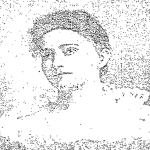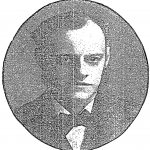 By Jean Lee Cole
By Jean Lee Cole
In 1906, Baltimore Sun reporter Emily Emerson Lantz described John Street as “a modest little scrap of a street—only six short blocks in all.” Yet what erudition, artistic inspiration, and human experience lived there. In “John Street and Its Celebrities” (Baltimore Sun, Apr. 8, 1906), Lantz, who lived herself at 1704 John, lovingly depicted some of her illustrious neighbors.
Lantz (1862-1931) got her start at the Baltimore News in 1894 before she was taken on by the Sun, where she wrote features, art criticism, and a regular column, “Frocks and Frills,” over the course of the next three decades. Her series on Maryland counties was eventually published in book form under the title The Spirit of Maryland (1929).
Lantz wrote:
John street is not an imposing thoroughfare from an architectural point of view. There is not a church, nor a club, nor a public building along its length. The term “palatial residence” could not by any flight of imagination be applied to a single one of its quite group of houses, but it is none the less picturesque, pre-eminently homelike and possesses an air of refinement. There are a good many trees, suggestive of the retirement of a country town, and diversity is accorded to almost every block by the interspersion of cottage houses, with plats of green grass and little porches before their entrances.
The latchkey of one householder is not a passkey to the entire block. Visitors recognize the houses of their acquaintances by some distinction architectural feature, and are not dependent upon an elusive number, or remembering that their friend’s home is the with step from the drug store. The interiors of the residences are as diversified as their exteriors.
But it is not for any of the above mentioned reasons that John street is unique among the streets of Baltimore. There is a quaint, pretty and hospitable adage, “The ornaments of the house are the guests who adorn it,” and as with houses so with neighborhood sections— it is the people who reside there who give to a locality character and distinctive interest. Cheyne Row, London, England, will be forever associated with the lives and literary work of Thomas and Jeanie (Welsh) Carlyle, with Dante Gabriel and Christina Rossetti, with Rev. H. R. Haweis and other distinguished writers, and quiet John street bears her literary laurels with so much modesty that Baltimoreans as a rule do not appreciate the fact that within the short six squares that comprise this street have been grouped the homes of an unusually brilliant coterie of literary men and women— writers some of whom are known upon both sides of the Atlantic Ocean, while all of them have achieved distinguished reputations in the world of letters.
And who were these illustrious figures?
- Thomas Smith Gregory Dabney (1303 John St.): “One of the wealthiest pioneer planters of Mississippi, whose fortune was swept away by the Civil War,” Lantz wrote; “a man of such heroic courage, such remarkable endowments and such peculiar sanctity as to almost consecrate as holy ground any spot which he might call home.”
- Lucy Meacham Thruston: “It is not often a writer fulfills in personality the ideals of womanhood presented to the imagination by the pen, but the authoress of ‘Mistress Brent’ is a very charming woman—lovable, approachable, with the freshness of April and the inspiration of October. She is in keeping with her stories. . . How often her John street neighbors have found a bunch of March violets upon their breakfast plate, or a dish of crisp cookies— proof of her Virginian housewifery skill in which she takes womanly pride— or a current magazine, with a page folded down and spicy marginal criticism annotating the article indicated. Only literary folk know the coziness of a literary neighbor.” (Thruston, it should be noted, lived at 254 Robert St., not John St. But apparently she lived close enough to count.)
- Katharine Pearson Woods (1508 John St.): Author of Metzerott, Shoemaker and other novels espousing the values of Christian Socialism. “It seems odd to imagine this gifted woman happy in the environment of primitive mountain people, yet she speaks with lighting eyes of her mission work, and one of her pleasantest relaxations, she said, is the delight of telling fairy stories to the mountain children, to whom the gates of the golden land of fairy imagining were never before unlocked.”
- Dr. Richard Henry Thomas (1718 John St.): Physician, poet, novelist, historian, orator; president of the Quaker Peace Association of America, dean of the Woman’s Medical College of Baltimore (which closed in 1910), “friend of the Quaker poet John Greenleaf Whittier,” and uncle of M. (Mary) Carey Thomas, founder of Bryn Mawr College. Lantz wrote, “While Baltimore was wrapped in a cloud of fire upon the appalling night of Feb. 7, 1904, Dr. Thomas is said to have preached at Light Street Mission, with a sea of flame dividing him from his home.”
- Mary F. Grace (1609 John St.): “Widely known in the United States” as a translator of works in French and Spanish.
- Kate Mason Rowland: Writer, historian, editor, and socialite, “a bird of passage that has nevertheless frequently alighted in Baltimore and for a season, at least, has called John Street home.”
- Eugene Lemoine Didier: “Well-known Maryland author,” expert on Edgar Allan Poe and author of The Life and Letters of Mme. Bonaparte (Elizabeth Patterson Bonaparte was a Baltimorean and wife of Napoleon Bonaparte III).
- Musicians including Jenny Lind Muller Green, “the talented pianist, organist and choir director,” Horace Hills, Jr., “composer and choirmaster of Mount Calvary Church,” Emily Whelan, an “orchestral director,” and organist Gertrude Woods.
- Artists, notably women artists, including M. Louisa Steuart (1611 John St.) and Ruth Johnston, “daughter of the noted writer, Richard Malcolm Johnston.” Both taught at MICA.
Lantz went on to name a variety of university professors and prominent members of the legal profession. It was, needless to say, an expansive compendium, running some four thousand words.
Who knew John St. could nurture so much human greatness? Nevertheless, at least one neighbor apparently felt left out. A few days after Lantz’s column was published, a letter to the Sun came from “An Unknown Author” who averred that “I, even I, with my family, live on John Street . . . It was really unkind in Miss Lantz to leave out the rest of us, as we are all celebrities in our own estimation, and as John Street is only ‘six blocks long,’ it would not have taken up much more of your valuable space for her to have mentioned all of us.”
Long Ago and Right Here features Bolton Hill news from the past, gleaned from the archives of the Baltimore Sun and other publications. We welcome submissions at editor@boltonhillmd.orgmd.org.
Jean Lee Cole is a professor of English at Loyola University Maryland and co-editor of the Bolton Hill Bulletin.


